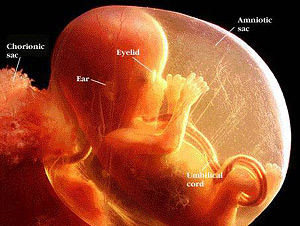Amniotic fluid is a liquid substance that surrounds a fetus within the uterus as it grows. This fluid provides numerous functions beneficial to the growing fetus. The fluid helps to prevent the uterus wall from constricting too tightly against the growing fetus, and it also acts as cushioning to prevent any harm upon the growing baby. The substance absorbs varying levels of carbohydrates, proteins, electrolytes, phospholipids and lipids as required for nourishment of the growing fetus.
Amniotic fluid begins to form around two weeks after fertilization has occurred. As the fluid resides within the body, and there are various types of vaginal discharge to be expected whilst pregnant, you may be wondering – what does amniotic fluid look like? Continue reading to find out.
What Does Amniotic Fluid Look Like?
Amniotic fluid is usually colorless, or of a slight yellow tint. Amniotic fluid does not smell urine; it can be odorless or have a sweetish smell. In some instances, amniotic fluid may have some flecks of blood or whitish mucus flecks.

How Do I Tell If I Have Urine, Discharge, or Amniotic Fluid?
Many women will experience vaginal leaking, and cannot figure out the leaking stuff. It can be urine, discharge or amniotic fluid, etc. Below we serve some useful information helping to identify the stuff.
- For amniotic fluid, if the leak continues overtime, even after you have emptied your bladder, then it is likely amniotic fluid, and your water may indeed be leaking.
- For urine, it is quite common in pregnancy, especially when proceeding to the second and third trimesters, during which the baby begins to press against the bladder. Urine is usually clear yellowish in color or darker than that. Its distinct odor is similar to that of ammonium.
- For vaginal discharge, it can be yellowish or whitish in color, and is usually thicker than urine or amniotic fluid. The discharge may or may not have an odor, yet if it did, it would be dissimilar to urine.
Below is a video detailing how to know if you're leaking amniotic fluid or not:
What Can Cause Amniotic Fluid to Leak?
There are numerous reasons that can be attributed as the cause for leaking amniotic fluid, such as:
- Infection (either in the uterus, cervix, or vagina)
- Previous history of premature amniotic puncture/rupture
- Previous surgeries on the cervix or uterus
- Poor lifestyle choices, such as alcohol, drugsand improper diet
- Psychological issues, such as stress
- A trauma/injury in the amniotic sac
- Amniotic sac defect
When Amniotic Fluid Is Abnormal?
There are instances when you are leaking amniotic fluid that is abnormal. As mentioned above, amniotic fluid is usually clear in color, or has a slight yellow tint.
Amniotic fluid that appears green or brown often indicates that the growing baby has passed their first bowel movement whilst in the uterus (meconium), yet, a baby will usually not have their first bowl movement until after they are born.If this happens, and the baby does pass meconium within the fetus, it can get into their lungs and cause serious breathing problems (known as meconium aspiration syndrome).In some instance, babies may need treatment immediately after birth to help prevent any breathing problems.
How to Deal With Premature Amniotic Fluid Leak
First, you need to be clear about that any significant amniotic fluid leak needs to be informed to your doctor and you need to visit a maternity ward or facility. There are instances where a premature amniotic fluid leak can be dangerous to your baby. How to deal with such conditions can be essential.
1. Before 34 Weeks
If you amniotic fluid leaks before 34 weeks, you should visit an appropriate medical facility as soon as possible. Your doctor will first check for signs of infection; if none are present, then they may attempt to hold off your labor, and supply your baby with steroidal medicines to help their lungs grow quicker. Your doctor will usually perform tests to check your baby's lungs, if they have grown sufficiently, then your doctor will likely induce labor.You may also be given antibiotics to help to prevent against infections.
2. Between 34 and 37 Weeks
If you experience a premature amniotic fluid leak between 34 and 37 weeks of your pregnancy, in most cases, your doctor will usually suggest that your labor is induced. In most scenarios, the premature birth of your baby will be better than risking you getting an infectionand waiting a few weeks for your predicted due date.
3. After 37 Weeks
If you have passed 37 weeks in your pregnancy when amniotic fluid begins to leak, it generally means your baby is prepared to be born. You should, however, go into labor soon, as the longer you wait, the higher chances an infection may occur.
Amniotic fluid leaking gives two choices: waiting for natural labor or inducing labor by your doctor which is done via the application of certain medications. On average, women who give birth with 24 hours of their water breaking are less likely to get an infection, meaning it can often be safer to induce labor if it hasn’t began after this time period has expired.
